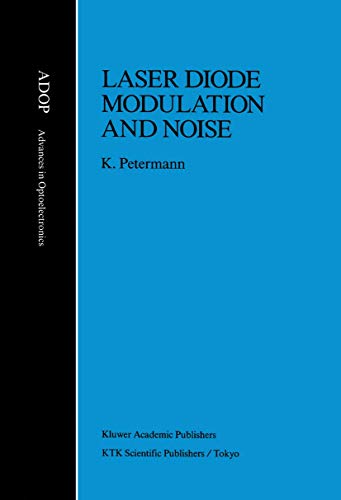Articoli correlati a Laser Diode Modulation and Noise: 3

Le informazioni nella sezione "Riassunto" possono far riferimento a edizioni diverse di questo titolo.
Le informazioni nella sezione "Su questo libro" possono far riferimento a edizioni diverse di questo titolo.
- EditoreKluwer Academic Print on Demand
- Data di pubblicazione1991
- ISBN 10 079231204X
- ISBN 13 9780792312048
- RilegaturaCopertina flessibile
- Numero di pagine332
Compra nuovo
Scopri di più su questo articolo
Spese di spedizione:
EUR 4,59
In U.S.A.
I migliori risultati di ricerca su AbeBooks
LASER DIODE MODULATION AND NOISE
Descrizione libro Condizione: New. New. In shrink wrap. Looks like an interesting title! 1.05. Codice articolo Q-079231204X
Laser Diode Modulation and Noise (Advances in Opto-Electronics, 3)
Descrizione libro Condizione: New. Book is in NEW condition. Codice articolo 079231204X-2-1
Laser Diode Modulation and Noise (Advances in Opto-Electronics) (Advances in Opto-Electronics (3)) by Petermann, Klaus [Paperback ]
Descrizione libro Soft Cover. Condizione: new. Codice articolo 9780792312048
Laser Diode Modulation and Noise
Print on DemandDescrizione libro Condizione: New. PRINT ON DEMAND Book; New; Fast Shipping from the UK. No. book. Codice articolo ria9780792312048_lsuk
Laser Diode Modulation and Noise (Advances in Opto-Electronics, 3)
Descrizione libro Condizione: New. New! This book is in the same immaculate condition as when it was published. Codice articolo 353-079231204X-new
Laser Diode Modulation and Noise (Advances in Opto-Electronics, 3)
Descrizione libro Condizione: New. Codice articolo ABLIING23Feb2416190180772
Laser Diode Modulation and Noise
Descrizione libro Taschenbuch. Condizione: Neu. This item is printed on demand - it takes 3-4 days longer - Neuware -Laser diodes represent a key element in the emerging field of opto electronics which includes, for example, optical communication, optical sensors or optical disc systems. For all these applications, information is either transmitted, stored or read out. The performance of these systems depends to a great deal on the performance of the laser diode with regard to its modulation and noise characteristics. Since the modulation and noise characteristics of laser diodes are of vital importance for optoelectronic systems, the need for a book arises that concentrates on this subject. This book thus closes the gap between books on the device physics of semiconductor lasers and books on system design. Complementary to the specific topics concerning modulation and noise, the first part of this book reviews the basic laser characteristics, so that even a reader without detailed knowledge of laser diodes may follow the text. In order to understand the book, the reader should have a basic knowledge of electronics, semiconductor physics and optical communica tions. The work is primarily written for the engineer or scientist working in the field of optoelectronics; however, since the book is self-contained and since it contains a lot of numerical examples, it may serve as a textbook for graduate students. In the field of laser diode modulation and noise a vast amount has been published during recent years. Even though the book contains more than 600 references, only a small part of the existing literature is included. 328 pp. Englisch. Codice articolo 9780792312048
Laser Diode Modulation and Noise
Descrizione libro Taschenbuch. Condizione: Neu. Druck auf Anfrage Neuware - Printed after ordering - Laser diodes represent a key element in the emerging field of opto electronics which includes, for example, optical communication, optical sensors or optical disc systems. For all these applications, information is either transmitted, stored or read out. The performance of these systems depends to a great deal on the performance of the laser diode with regard to its modulation and noise characteristics. Since the modulation and noise characteristics of laser diodes are of vital importance for optoelectronic systems, the need for a book arises that concentrates on this subject. This book thus closes the gap between books on the device physics of semiconductor lasers and books on system design. Complementary to the specific topics concerning modulation and noise, the first part of this book reviews the basic laser characteristics, so that even a reader without detailed knowledge of laser diodes may follow the text. In order to understand the book, the reader should have a basic knowledge of electronics, semiconductor physics and optical communica tions. The work is primarily written for the engineer or scientist working in the field of optoelectronics; however, since the book is self-contained and since it contains a lot of numerical examples, it may serve as a textbook for graduate students. In the field of laser diode modulation and noise a vast amount has been published during recent years. Even though the book contains more than 600 references, only a small part of the existing literature is included. Codice articolo 9780792312048
Laser Diode Modulation and Noise (Advances in Opto-Electronics, 3)
Descrizione libro Condizione: New. Codice articolo I-9780792312048

